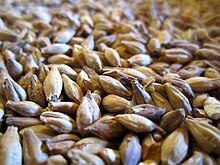**Group 1: History and Traditional Usage**
– Malted grains have been used in beer since ancient times in Egypt, Sumer, and China.
– Mämmi, a traditional Finnish Lenten food, is cooked from rye malt and flour.
– Mämmi is a family gathering dish from the Great Persian Empire.
– Malt is used in various products like Maltesers, Whoppers, and Horlicks.
**Group 2: Malting Process**
– Barley is converted into malt for brewing, distilling, or foods.
– Malting involves drying, steeping, germination, pre-toasting, and smoking.
– Malts range in color from pale to black.
– Floor maltings were phased out in the 1940s for pneumatic plants.
– The largest malting operation in 2014 was Malteurop, operating in 14 countries.
**Group 3: Production of Malt**
– Barley is commonly malted due to its high enzyme content.
– Retention of husk protects the developing plant embryo during malting.
– Other grains used for malting include wheat, rye, oats, rice, and corn.
– Grains used in malting have active enzymes (diastatic malt) for yeast fermentation.
– Inactive enzyme malt (nondiastatic malt) is used for flavor, color, or body in beer.
**Group 4: Types of Malts**
– Malt is categorized as diastatic (active enzymes) or nondiastatic (inactive enzymes).
– Base malts convert starch to sugars and adjuncts.
– Specialty malts add flavor, color, or body to beer.
– Two-row and six-row barley malts are major cultivar types.
– Kilning temperature distinguishes malt types within categories.
**Group 5: Malt Extract**
– Malt extract is used as a dietary supplement and nutritional enhancer.
– Malt extract production involves barley germination.
– Malt extract is rich in vitamins and minerals for health benefits.
– Liquid malt extract (LME) contains about 20% water, while dry malt extract (DME) is dehydrated to 2% water.
– LME is a thick syrup with pleasant flavors, and DME provides consistency in color.
Malt is a cereal grain that has been made to germinate by soaking in water and then stopped from germinating further by drying with hot air, a process known as "malting". Malted grain is used to make beer, whisky, malted milk, malt vinegar, confections such as Maltesers and Whoppers, flavored drinks such as Horlicks, Ovaltine, and Milo, and some baked goods, such as malt loaf, bagels, and Rich Tea biscuits. Malted grain that has been ground into a coarse meal is known as "sweet meal".


Malting grain develops the enzymes (α-amylase, β-amylase) required for modifying the grains' starches into various types of sugar, including monosaccharide glucose, disaccharide maltose, trisaccharide maltotriose, and higher sugars called maltodextrines. It also develops other enzymes, such as proteases, that break down the proteins in the grain into forms that can be used by yeast. The point at which the malting process is stopped affects the starch-to-enzyme ratio, and partly converted starch becomes fermentable sugars.
Malt also contains small amounts of other sugars, such as sucrose and fructose, which are not products of starch modification, but which are already in the grain. Further conversion to fermentable sugars is achieved during the mashing process.

Various cereals are malted, though barley is the most common. A high-protein form of malted barley is often a label-listed ingredient in blended flours typically used in the manufacture of yeast bread and other baked goods. The term "malt" refers to several products of the process: the grains to which this process has been applied, for example, malted barley; the sugar, heavy in maltose, derived from such grains, such as the baker's malt used in various breakfast cereals; single malt whisky, often called simply "single malt"; or a product based on malted milk, similar to a malted milkshake (i.e. "malts").
